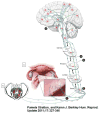Relating Chronic Pelvic Pain and Endometriosis to Signs of Sensitization and Myofascial Pain and Dysfunction
- PMID: 28049214
- PMCID: PMC5585080
- DOI: 10.1055/s-0036-1597123
Relating Chronic Pelvic Pain and Endometriosis to Signs of Sensitization and Myofascial Pain and Dysfunction
Abstract
Chronic pelvic pain is a frustrating symptom for patients with endometriosis and is frequently refractory to hormonal and surgical management. While these therapies target ectopic endometrial lesions, they do not directly address pain due to central sensitization of the nervous system and myofascial dysfunction, which can continue to generate pain from myofascial trigger points even after traditional treatments are optimized. This article provides a background for understanding how endometriosis facilitates remodeling of neural networks, contributing to sensitization and generation of myofascial trigger points. A framework for evaluating such sensitization and myofascial trigger points in a clinical setting is presented. Treatments that specifically address myofascial pain secondary to spontaneously painful myofascial trigger points and their putative mechanisms of action are also reviewed, including physical therapy, dry needling, anesthetic injections, and botulinum toxin injections.
Thieme Medical Publishers 333 Seventh Avenue, New York, NY 10001, USA.
Figures

Similar articles
-
Myofascial Pelvic Pain: An Overlooked and Treatable Cause of Chronic Pelvic Pain.J Midwifery Womens Health. 2021 Mar;66(2):148-160. doi: 10.1111/jmwh.13224. Epub 2021 Mar 31. J Midwifery Womens Health. 2021. PMID: 33788379 Review.
-
Association of chronic pelvic pain and endometriosis with signs of sensitization and myofascial pain.Obstet Gynecol. 2015 Mar;125(3):719-728. doi: 10.1097/AOG.0000000000000663. Obstet Gynecol. 2015. PMID: 25730237 Free PMC article.
-
Consensus guidelines for the management of chronic pelvic pain.J Obstet Gynaecol Can. 2005 Sep;27(9):869-910. doi: 10.1016/s1701-2163(16)30993-8. J Obstet Gynaecol Can. 2005. PMID: 19830953 English, French.
-
Myofascial pelvic pain: the forgotten player in chronic pelvic pain.Curr Opin Obstet Gynecol. 2024 Aug 1;36(4):273-281. doi: 10.1097/GCO.0000000000000966. Epub 2024 May 21. Curr Opin Obstet Gynecol. 2024. PMID: 38837702 Review.
-
Recognizing myofascial pelvic pain in the female patient with chronic pelvic pain.J Obstet Gynecol Neonatal Nurs. 2012 Sep-Oct;41(5):680-91. doi: 10.1111/j.1552-6909.2012.01404.x. Epub 2012 Aug 3. J Obstet Gynecol Neonatal Nurs. 2012. PMID: 22862153 Free PMC article. Review.
Cited by
-
Sexual function in women with endometriosis and pelvic floor myofascial pain syndrome.Rev Bras Ginecol Obstet. 2024 May 27;46:e-rbgo40. doi: 10.61622/rbgo/2024rbgo40. eCollection 2024. Rev Bras Ginecol Obstet. 2024. PMID: 39381337 Free PMC article.
-
Exploring the Influence of IL-8, IL-10, Patient-Reported Pain, and Physical Activity on Endometriosis Severity.Diagnostics (Basel). 2024 Aug 21;14(16):1822. doi: 10.3390/diagnostics14161822. Diagnostics (Basel). 2024. PMID: 39202309 Free PMC article.
-
Evaluating the Correlation between Myofascial Pelvic Pain and Female Sexual Function: A Prospective Pilot Study.J Clin Med. 2024 Aug 6;13(16):4604. doi: 10.3390/jcm13164604. J Clin Med. 2024. PMID: 39200746 Free PMC article.
-
Risk factors and nomogram construction for predicting women with chronic pelvic pain:a cross-sectional population study.Heliyon. 2024 Jul 15;10(14):e34534. doi: 10.1016/j.heliyon.2024.e34534. eCollection 2024 Jul 30. Heliyon. 2024. PMID: 39156584 Free PMC article.
-
Holistic Approaches in Endometriosis - as an Effective Method of Supporting Traditional Treatment: A Systematic Search and Narrative Review.Reprod Sci. 2024 Nov;31(11):3257-3274. doi: 10.1007/s43032-024-01660-2. Epub 2024 Jul 23. Reprod Sci. 2024. PMID: 39043999 Free PMC article. Review.
References
-
- Practice bulletin no. 114: management of endometriosis. Obstet Gynecol. 2010;116(1):223–236. - PubMed
-
- Vercellini P, Fedele L, Aimi G, Pietropaolo G, Consonni D, Crosignani PG. Association between endometriosis stage, lesion type, patient characteristics and severity of pelvic pain symptoms: a multivariate analysis of over 1000 patients. Hum Reprod. 2007;22(1):266–271. - PubMed
-
- Institute of Medicine (US) Committee on Pain D, and Chronic Illness Behavior. The Anatomy and Physiology of Pain. In: Osterweis M, Kleinman A, Mechanic D, editors. Pain and Disability: Clinical, Behavioral, and Public Policy Perspectives. Washington, DC: National Academy Press; 1987. pp. 123–145. - PubMed
Publication types
MeSH terms
Substances
Grants and funding
LinkOut - more resources
Full Text Sources
Other Literature Sources
Medical

